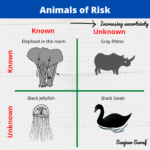Green is “In”.
Consumers, retail stores, and corporate policies are all going green.
But just because you have a green technology does not mean you have ZERO risks. Let me give you a couple of examples.
Biofuel Industry
As I have pointed out in an earlier post (Fires and Explosions in Biofuel Industry) biofuel industry is exhibiting a disturbing trend of accidents. The biodiesel industry is experiencing one fire/explosion incident every 10-weeks.
Replacing Ozone Depleting Refrigerants
In an effort to curb global warming, there is an increased push to replace halogenated refrigerants that can damage ozone layer. Facilities that required industrial scale refrigeration systems are turning to ammonia as an alternative to synthetic refrigerants. Ammonia is a known toxicant – irritating at low exposures and fatal at high concentrations. The facilities that will start using ammonia are present in your neighborhood – warehouses of grocery stores, ice cream factories, indoor hockey arenas. Imagine an ammonia release at locations close to public.
Even Green Technologies Need a Risk Management Plan
Green technologies are environmentally friendlier and often portrayed as the preferred alternative…true as it may be it does not imply green technologies do not pose risks.
One cannot neglect hazard identification and risk mitigation strategies even for green technologies.






8 Responses
Very informative post. I would like to emphasize where my research work at the Combustible Dust Policy Institute has indicated that biodiesel industry is experiencing an average of one fire/explosion incident every 10-weeks is not conclusive. Many more incidents could of occurred that were not reported by the media or I missed them while conducting daily web searches.
Dr. Saraf,
You make a very valid and important point. It has been my experience that emerging technologies often lag in safety as the technology and process dangers develop. Your readers may note that biofuels are both liquid and solid forms.
I can speak directly to the pellet Industry, and specifically to the wood pellet processes as this growth industry is now experiencing critical mass with 100 pellet plants in N.America and an ever increasing number of incidents of fires and explosions.
Fires and explosions in this industry are predominantly due to lack of awareness of the combustibility of the product and byproduct from these processes, as well as lack of properly designed process controls, dust collection and safety systems, and understanding of current standards and code, as well as enforcement.
Although NFPA 664 is now the current best engineering practice for the prevention of fires and explosions in the wood products industry, and chapter 8 outlines in great detail how to protect theses systems, including making processes intrinsically safe, housekeeping, change management, etc., this industry does not yet realize that NFPA 654 has been adopted by and referenced by controlling OSHA documents such as their NEP on comdust. Or that the IBC International Building Code and International Fire Code incorporates NFPA 654 by reference.
The problem currently are the unresolved issues regarding OSHA and preemption, especially in states without OSHA state plans. -Jeff Nichols
FYI:Four persons were killed and three others injured after an explosion rocked the 2,000 square feet concrete tank of a bio gas plant in Edathala, India Wednesday August 26, 2009.
http://www.ptinews.com/news/250351_4-killed–3-injured-in-bio-gas-plant-explosion
Excellent point Jeff, in the nearly two dozen states with state plans and not required to adhere to the OSHA Dust NEP, which is strictly voluntary.
is the biofuel industry neglecting many known safety hazards in the midst of reducing production cost to compete with petroleum?
Mr. Lim…I agree that at the moment the margins in biofuel industry are thin. But I’m not sure I would necessarily attribute the incidents to cost. The post below is a better answer to your question:
http://risk-safety.com/risksafetynewsite/biofuel-safety-is-it-time-for-bio-psm/
Excellent Work! I really enjoyed reading this. I was considering working on a course on the hazards of Green Technologies. I’ve been interested in this aspect because I don’t think it’s receiving alot of attention.
Dave Barber, MS, CIH
Hi Dave…thanks for your comments. Feel free to contact me if you need any further information.
I hope you also subscribe to the blog.
Dr. Saraf, I’d love to hear more. This is a study area of mine as well. If you have studies, I’d be interesting in reading them.
Dave